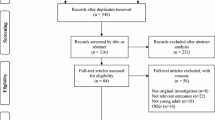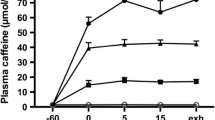Abstract
Exercise induces release of cytokines and increase of circulating natural killers (NK) lymphocyte during strong activation of respiratory muscles. We hypothesised that non-fatiguing respiratory muscle loading during exercise causes an increase in NK cells and in metabolic stress indices. Heart rate (HR), ventilation (VE), oesophageal pressure (Pes), oxygen consumption (VO2), dyspnoea and leg effort were measured in eight healthy humans (five men and three women, average age of 31 ± 4 years and body weight of 68 ± 10 kg), performing an incremental exercise testing on a cycle ergometer under control condition and expiratory flow limitation (FL) achieved by putting a Starling resistor. Blood samples were obtained at baseline, at peak of exercise and at iso-workload corresponding to that reached at the peak of FL exercise during control exercise. Diaphragmatic fatigue was evaluated by measuring the tension time index of the diaphragm. Respiratory muscle overloading caused an earlier interruption of exercise. Diaphragmatic fatigue did not occur in the two conditions. At peak of flow-limited exercise compared to iso-workload, HR, peak inspiratory and expiratory Pes, NK cells and norepinephrine were significantly higher. The number of NK cells was significantly related to ΔPes (i.e. difference between the most and the less negative Pes) and plasmatic catecholamines. Loading of respiratory muscles is able to cause an increase of NK cells provided that activation of respiratory muscles is intense enough to induce a significant metabolic stress.






Similar content being viewed by others
References
Abraham KA, Feingold H, Fuller DD, Jenkins M, Mateika JH, Fregosi RF (2002) Respiratory-related activation of human abdominal muscles during exercise. J Physiol Lond 541:653–663
Aliverti A (2016) The respiratory muscles during exercise. Breathe (Sheff) 12:165–168. https://doi.org/10.1183/20734735.008116
Aliverti A, Dellacà RL, Lotti P, Bertini S, Duranti R, Scano G, Heyman J, Lo Mauro A, Pedotti A, Macklem PT (2005) Influence of expiratory flow-limitation during exercise on systemic oxygen delivery in humans. Eur J Appl Physiol 95:229–242. https://doi.org/10.1007/s00421-005-1386-4
Athanasopoulos D, Louvaris Z, Cherouveim E, Andrianopoulos V, Roussos C, Zakynthinos S, Vogiatzis I (2010) Expiratory muscle loading increases intercostal muscle blood flow during leg exercise in healthy humans. J Appl Physiol 109:388–395. https://doi.org/10.1152/japplphysiol.01290.2009
Bellemare F, Grassino A (1982) Effect of pressure and timing of contraction on human diaphragm fatigue. J Appl Physiol Respir Environ Exerc Physiol 53:1190–1195
Benschop RJ, Oostveen FG, Heijnen CJ, Ballieux RE (1993) Beta 2-adrenergic stimulation causes detachment of natural killer cells from cultured endothelium. Eur J Immunol 23:3242–3247. https://doi.org/10.1002/eji.1830231230
Borg GA (1982) Psychophysical bases of perceived exertion. Med Sci Sports Exerc 14:377–381
Bruunsgaard H, Galbo H, Halkjaer-Kristensen J, Johansen TL, MacLean DA, Pedersen BK (1997) Exercise-induced increase in serum interleukin-6 in humans is related to muscle damage. J Physiol Lond 499(Pt 3):833–841
Field CJ, Gougeon R, Marliss EB (1991) Circulating mononuclear cell numbers and function during intense exercise and recovery. J Appl Physiol 71:1089–1097
Haskell WL, Lee I-M, Pate RR, Powell KE, Blair SN, Franklin BA, Macera CA, Heath GW, Thompson PD, Bauman A (2007) Physical activity and public health: updated recommendation for adults from the American College of Sports Medicine and the American Heart Association. Med Sci Sports Exerc 39:1423–1434. https://doi.org/10.1249/mss.0b013e3180616b27
Iandelli I, Aliverti A, Kayser B, Dellacà R, Cala SJ, Duranti R, Kelly S, Scano G, Sliwinski P, Yan S, Macklem PT, Pedotti A (2002) Determinants of exercise performance in normal men with externally imposed expiratory flow limitation. J Appl Physiol 92:1943–1952. https://doi.org/10.1152/japplphysiol.00393.2000
Jones NL, Makrides L, Hitchcock C, Chypchar T, McCartney N (1985) Normal standards for an incremental progressive cycle ergometer test. Am Rev Respir Dis 131:700–708. https://doi.org/10.1164/arrd.1985.131.5.700
Kappel M, Tvede N, Galbo H, Haahr PM, Kjaer M, Linstow M, Klarlund K, Pedersen BK (1991) Evidence that the effect of physical exercise on NK cell activity is mediated by epinephrine. J Appl Physiol 70:2530–2534
Katsaounou P, Karatza MH, Kollintza A et al (2001) The immune response to strenuous resistive breathing (abstract). Am J Respir Crit Care Med 163:A62115
Kayser B, Sliwinski P, Yan S, Tobiasz M, Macklem PT (1997) Respiratory effort sensation during exercise with induced expiratory-flow limitation in healthy humans. J Appl Physiol 83:936–947
Laveneziana P, Montani D, Dorfmüller P, Girerd B, Sitbon O, Jaïs X, Savale L, Eyries M, Soubrier F, Similowski T, Simonneau G, Humbert M, Garcia G (2014) Mechanisms of exertional dyspnoea in pulmonary veno-occlusive disease with EIF2AK4 mutations. Eur Respir J 44:1069–1072. https://doi.org/10.1183/09031936.00088914
Laveneziana P, O’Donnell DE, Ofir D, Agostoni P, Padeletti L, Ricciardi G, Palange P, Duranti R, Scano G (2009) Effect of biventricular pacing on ventilatory and perceptual responses to exercise in patients with stable chronic heart failure. J Appl Physiol 106:1574–1583. https://doi.org/10.1152/japplphysiol.90744.2008
Laveneziana P, Webb KA, Wadell K, Neder JA, O’Donnell DE (2014) Does expiratory muscle activity influence dynamic hyperinflation and exertional dyspnea in COPD? Respir Physiol Neurobiol 199:24–33. https://doi.org/10.1016/j.resp.2014.04.005
Lieberman DA, Faulkner JA, Craig AB, Maxwell LC (1973) Performance and histochemical composition of guinea pig and human diaphragm. J Appl Physiol 34:233–237
Loverdos K, Toumpanakis D, Litsiou E, Karavana V, Glynos C, Magkou C, Theocharis S, Vassilakopoulos T (2016) The differential effects of inspiratory, expiratory, and combined resistive breathing on healthy lung. Int J Chron Obstruct Pulmon Dis 11:1623–1638. https://doi.org/10.2147/COPD.S106337
Martin JG, De Troyer A (1982) The behaviour of the abdominal muscles during inspiratory mechanical loading. Respir Physiol 50:63–73
Mazzeo RS (1991) Catecholamine responses to acute and chronic exercise. Med Sci Sports Exerc 23:839–845
Mazzeo RS, Marshall P (1989) Influence of plasma catecholamines on the lactate threshold during graded exercise. J Appl Physiol 67:1319–1322
McCarthy DA, Dale MM (1988) The leucocytosis of exercise. A review and model. Sports Med 6:333–363
Miller JM, Moxham J, Green M (1985) The maximal sniff in the assessment of diaphragm function in man. Clin Sci 69:91–96
Miller MR (2005) Standardisation of spirometry. Eur Respir J 26:319–338. https://doi.org/10.1183/09031936.05.00034805
Moldoveanu AI, Shephard RJ, Shek PN (2000) Exercise elevates plasma levels but not gene expression of IL-1beta, IL-6, and TNF-alpha in blood mononuclear cells. J Appl Physiol 89:1499–1504
Neri Serneri GG, Masotti G, Castellani S, Scarti L, Trotta F, Mannelli M (1983) Role of PGE2 in the modulation of the adrenergic response in man. Cardiovasc Res 17:662–670
Nielsen HG, Øktedalen O, Opstad P-K, Lyberg T (2016) Plasma cytokine profiles in long-term strenuous exercise. J Sports Med (Hindawi Publ Corp) 2016:7186137. https://doi.org/10.1155/2016/7186137
Nieman DC, Nehlsen-Cannarella SL, Donohue KM, Chritton DB, Haddock BL, Stout RW, Lee JW (1991) The effects of acute moderate exercise on leukocyte and lymphocyte subpopulations. Med Sci Sports Exerc 23:578–585
Ostrowski K, Rohde T, Zacho M, Asp S, Pedersen BK (1998) Evidence that interleukin-6 is produced in human skeletal muscle during prolonged running. J Physiol Lond 508(Pt 3):949–953
Pedersen BK (2000) Special feature for the Olympics: effects of exercise on the immune system: exercise and cytokines. Immunol Cell Biol 78:532–535. https://doi.org/10.1111/j.1440-1711.2000.t01-11-.x
Pedersen BK, Hoffman-Goetz L (2000) Exercise and the immune system: regulation, integration, and adaptation. Physiol Rev 80:1055–1081
Pedersen BK, Toft AD (2000) Effects of exercise on lymphocytes and cytokines. Br J Sports Med 34:246–251
Quanjer PH, Tammeling GJ, Cotes JE, Pedersen OF, Peslin R, Yernault JC (1993) Lung volumes and forced ventilatory flows. Eur Respir J 6(Suppl 16):5–40. https://doi.org/10.1183/09041950.005s1693
Ross RM (2003) ATS/ACCP statement on cardiopulmonary exercise testing. Am J Respir Crit Care Med 167:1451; author reply 1451. https://doi.org/10.1164/ajrccm.167.10.950
Shephard RJ (2003) Limits to the measurement of habitual physical activity by questionnaires. Br J Sports Med 37:197–206 discussion 206
Strohl KP, Mead J, Banzett RB, Loring SH, Kosch PC (1981) Regional differences in abdominal muscle activity during various maneuvers in humans. J Appl Physiol Respir Environ Exerc Physiol 51:1471–1476
Sugiura H, Sako S, Oshida Y (2013) Effect of expiratory muscle fatigue on the respiratory response during exercise. J Phys Ther Sci 25:1491–1495. https://doi.org/10.1589/jpts.25.1491
Timmons BW, Cieslak T (2008) Human natural killer cell subsets and acute exercise: a brief review. Exerc Immunol Rev 14:8–23
Ullum H, Haahr PM, Diamant M, Palmø J, Halkjaer-Kristensen J, Pedersen BK (1994) Bicycle exercise enhances plasma IL-6 but does not change IL-1 alpha, IL-1 beta, IL-6, or TNF-alpha pre-mRNA in BMNC. J Appl Physiol 77:93–97
Uribe JM, Stump CS, Tipton CM, Fregosi RF (1992) Influence of exercise training on the oxidative capacity of rat abdominal muscles. Respir Physiol 88:171–180
Vassilakopoulos T, Roussos C, Zakynthinos S (2004) The immune response to resistive breathing. Eur Respir J 24:1033–1043. https://doi.org/10.1183/09031936.04.00067904
Vassilakopoulos T, Zakynthinos S, Roussos C (1999) Strenuous resistive breathing induces proinflammatory cytokines and stimulates the HPA axis in humans. Am J Phys 277:R1013–R1019
Acknowledgements
We would like to sincerely thank Dr. Roberta Biagiotti and Maria G. Giudizi from the Department of Internal Medicine, Section of Clinical Immunology and Respiratory Diseases, University of Florence, Italy, for their technical assistance in processing blood samples, characterising lymphocyte subpopulations, and quantifying cytokine, plasmatic catecholamines and muscle enzymes.
Supported by the programme “Investissement d’Avenir ANR-10-AIHU 06 of the French Government.
Author information
Authors and Affiliations
Corresponding author
Ethics declarations
The research was carried out in accordance with the principles outlined in the Declaration of Helsinki. The study was approved by the local ethics committee, and all the subjects signed written, informed consent after a detailed description of the protocol at the time of their first assessment.
Rights and permissions
About this article
Cite this article
Rolland-Debord, C., Morelot-Panzini, C., Similowski, T. et al. Effects of non-fatiguing respiratory muscle loading induced by expiratory flow limitation during strenuous incremental cycle exercise on metabolic stress and circulating natural killer cells. Pflugers Arch - Eur J Physiol 469, 1533–1544 (2017). https://doi.org/10.1007/s00424-017-2070-3
Received:
Revised:
Accepted:
Published:
Issue Date:
DOI: https://doi.org/10.1007/s00424-017-2070-3




